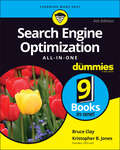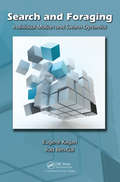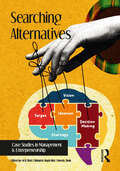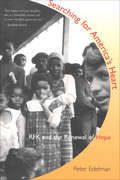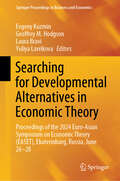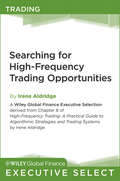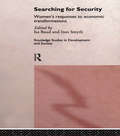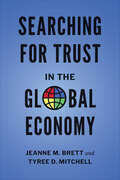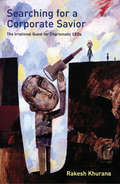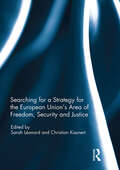- Table View
- List View
Search Engine Optimization All-in-One For Dummies
by Bruce Clay Kristopher B. JonesGet search engines to rank your site as the No. 1 result with help from this comprehensive resource What's the best hiding place in the world? The second page of Google's search results! If you want your website to be found, you need to make sure it appears prominently on search engines. In Search Engine Optimization All-in-One For Dummies, you'll find practical and easy-to-follow advice to increase your site's chances of landing that coveted No. 1 spot on Google, Bing, and other popular search engines. You'll discover how search engines decide which websites to rank highly, how to optimize your site for your best chance at the first page of organic results, what keywords to target, and even how to make your site internationally visible. You'll also find out how to: Optimize your webpage with responsive design that makes it irresistible to Google Create a keyword strategy that keeps interested and engaged visitors flowing to your website Generate the backlinks that will teach Google you're a trusted resource and help you climb the search engine results page Perfect for webmasters, bloggers, e-commerce professionals, and anyone else looking for more online visibility, Search Engine Optimization All-in-One For Dummies is a must-have guide to improving the quantity and quality of your web traffic.
Search Inside Yourself: The Unexpected Path to Achieving Success, Happiness (and World Peace)
by Daniel Goleman Jon Kabat-Zinn Chade-Meng TanFor the benefits of meditation to become widely accessible to humanity, it cannot just be the domain of bald people in funny robes living in mountains, or small groups of New Age folks in San Francisco. Meditation needs to become "real." It needs to align with the lives and interests of real people.--from Search Inside YourselfEarly Google engineer and personal growth pioneer Chade-Meng Tan first designed Search Inside Yourself as a popular course at Google intended to transform the work and lives of the best and brightest behind one of the most innovative, successful, and profitable businesses in the world . . . and now it can do the same for you. Meng has distilled emotional intelligence into a set of practical and proven tools and skills that anyone can learn and develop. Created in collaboration with a Zen master, a CEO, a Stanford University scientist, and Daniel Goleman (the guy who literally wrote the book on emotional intelligence), this program is grounded in science and expressed in a way that even a skeptical, compulsively pragmatic, engineering-oriented brain like Meng's can process. Whether your intention is to reduce stress and increase well-being, heighten focus and creativity, become more optimistic and resilient, build fulfilling relationships, or just be successful, the skills provided by Search Inside Yourself will prove invaluable for you. This is your guide to enhancing productivity and creativity, finding meaning and fulfillment in your work and life, and experiencing profound peace, compassion, and happiness while doing so. Search Inside Yourself reveals how to calm your mind on demand and return it to a natural state of happiness, deepen self-awareness in a way that fosters self-confidence, harness empathy and compassion into outstanding leadership, and build highly productive collaborations based on trust and transparent communication. In other words, Search Inside Yourself shows you how to grow inner joy while succeeding at your work. Meng writes: "Some people buy books that teach them to be liked; others buy books that teach them to be successful. This book teaches you both. You are so lucky."
Search Marketing Strategies
by James ColbornSearch Marketing Strategies focuses on how to make the most from the search engine industry. Concentrating on the strategic element rather than the procedural approach, the author demonstrates how to adapt the tactical techniques, such as paid search, site side optimization and analytics packages, into search strategies in order to achieve marketing or corporate objectives such as branding, sales and customer acquisition.
Search Marketing: A Strategic Approach to SEO and SEM
by Kelly CutlerIncrease the power of your marketing budget and enhance customer reach with fundamental search marketing efforts, SEO and SEM. This comprehensive guide delves into the dynamic world of both paid and organic search marketing strategies, providing an in-depth understanding of the tactics and techniques that drive successful online visibility and business growth. As the digital marketing landscape continues to evolve, this work gets more technical, time-consuming and costly. Discover how to approach both paid and organic search marketing like a digital strategist by reading this book from digital marketing expert and educator, Kelly Cutler. Search Marketing offers insights into high-level fundamentals and advanced applications. Designed to help marketers and businesses leaders get more from this essential digital marketing tactic, the book dives into what marketers can do today to help their companies take a more controlled, intentional, and strategic approach to SEO and SEM. The book delivers techniques for increasing visibility, driving qualified traffic, measuring the success and functionality of SEO, SEM campaigns and advanced methods for campaign optimization. Readers will walk away knowing how to take a more informed approach to the business they bring from sites like Google and Bing, while gaining the insight necessary to effectively oversee search marketing at a strategic level.
Search and Foraging: Individual Motion and Swarm Dynamics
by Eugene Kagan Irad Ben-GalSince the start of modern computing, the studies of living organisms have inspired the progress in developing computers and intelligent machines. In particular, the methods of search and foraging are the benchmark problems for robotics and multi-agent systems. The highly developed theory of search and screening involves optimal search plans that ar
Search for the Ultimate Energy Source
by Stephen O. DeanWhy has the clean, limitless energy promised by fusion always seemed just out of reach? Search for the Ultimate Energy Source: A History of the U.S. Fusion Energy Program, explains the fundamentals and concepts behind fusion power, and traces the development of fusion historically by decade--covering its history as dictated by US government policies, its major successes, and its prognosis for the future. The reader will gain an understanding of how the development of fusion has been shaped by changing government priorities as well as other hurdles currently facing realization of fusion power. Advance Praise for Search for the Ultimate Energy Source: "Dr. Dean has been uniquely involved in world fusion research for decades and, in this book, describes the complicated realities like few others possibly could." -Robert L. Hirsch, a former director of the US fusion program, an Assistant Administrator of the US Energy Research and Development Administration (ERDA); an executive at Exxon, Arco, and the Electric Power Research Institute (EPRI); and lead author of the book The Impending World Energy Mess (Apogee Prime Books, 2009). "In this book, Dr. Dean provides the many reasons why fusion has progressed more slowly than many had hoped. Budget is usually cited as the culprit, but policy is equally to blame. Facilities have been closed down before their jobs were done--or in some cases, even started. It seems this situation has become endemic in fusion, and if one thinks about it, in other nationally important Science and Technology initiatives as well." -William R. Ellis, a former scientist at Los Alamos National Laboratory, Associate Director of Research at the US Naval Research Laboratory, a vice president at Ebasco Services and at Raytheon, and chair of the US ITER Industry Council and the US ITER Industrial Consortium.
Search in the Labor Market under Imperfectly Insurable Income Risk
by Mauro RocaA report from the International Monetary Fund.
Search: How the Data Explosion Makes Us Smarter
by Stefan WeitzSearch is as old as language. There has always been a need for one to find something in the jumble of human creation. The first web was nothing more than passing verbal histories down the generations so others could find and remember how not to get eaten; the first search used the power of written language to build simple indexes in printed books, leading to the Dewey Decimal system and reverse indices in more modern times. Then digital happened. Besides having profound societal impacts, it also made the act of searching almost impossibly complex for both engines and searchers. Information isn't just words; it is pictures, videos, thoughts tagged with geocode data, routes, physical world data, and, increasingly, the machines themselves reporting their condition and listening to others. Search: How the Data Explosion Makes Us Smarter holds up a mirror to our time to see if search can keep up. Author Stefan Weitz, Director of Search for Bing (Microsoft), explores the idea of access to help readers understand how we are inventing new ways to access data through devices in more places and with more capabilities. We are at the cusp of imbuing our generation with superpowers, but only if we fundamentally rethink what search is, how people can use it, and what we should demand of it.
Search: How the Data Explosion Makes Us Smarter (Greenhouse Collection)
by Stefan WeitzSearch is as old as language. We've always needed to find something in the jumble of human creation. The first web was nothing more than passing verbal histories down the generations so others could find and remember how not to get eaten; the first search used the power of written language to build simple indexes in printed books, leading to the Dewey Decimal system and reverse indices in more modern times. Then digital happened. Besides having profound societal impacts, it also made the act of searching almost impossibly complex for both engines and searchers. Information isn't just words; it is pictures, videos, thoughts tagged with geocode data, routes, physical world data, and, increasingly, the machines themselves reporting their condition and listening to others'. Search: How the Data Explosion Makes Us Smarter holds up a mirror to our time to see if search can keep up. Author Stefan Weitz explores the idea of access to help readers understand how we are inventing new ways to search and access data through devices in more places and with more capabilities. We are at the cusp of imbuing our generation with superpowers, but only if we fundamentally rethink what search is, how people can use it, and what we should demand of it. "Search: How The Data Explosion Makes Us Smarter" is the first title from GreenHouse Collection. Created by the founders of Insight Labs, the world's first philanthropic think tank, GreenHouse Collection features books that encourage deeper exploration and inquiry to inform new models for social good.
Searching Alternatives: Case Studies in Management & Entrepreneurship
by M. R. Dixit Siddarth Singh Bist Sweety ShahIn the growth of societies, business and entrepreneurship are regarded as two significant and determinative concerns. Both notions, in reality, must be intertwined since they are the instruments for strengthening the stake on innovation, creativity, employment, and economic growth. As a result, management and entrepreneurship education must be promoted, and real-life managerial entrepreneurial stories can serve as role models for young students in India. The case study methodology is a significant pedagogy tool in the management education. The book is an attempt to disseminate the innovative and practice-based teaching material on management and entrepreneurship for higher education, with a focus on real-life contexts and practical learning. The case studies in the book include a rich variety of managerial and entrepreneurial challenges that have to be understood and solved in the real world, giving the student a dynamic experience on how to solve real world managerial and entrepreneurial challenges.
Searching for America's Heart: RFK and the Renewal of Hope
by Peter EdelmanFrom an author who resigned from the Clinton administration: “Part memoir and part manifesto . . . a beautifully written call to renew the fight against poverty.”?Jonathan Kozol, New York Times bestselling author of Savage InequalitiesPeter Edelman has worked as an aide to Robert F. Kennedy, a lawyer, a children’s advocate, and a policymaker. He has devoted his life to the cause of justice and to ending inequality. But in 1996, while serving in the Clinton administration as an expert on welfare policy and children, he found himself in an untenable position. The president signed a new welfare bill that ended a sixty-year federal commitment to poor children, and as justification invoked the words of RFK. For Edelman, Clinton’s twisting of Kennedy’s vision was deeply cynical, so in a rare gesture that sparked front-page headlines, he resigned. The nation, he believed, had been harmed.In this book, he shows that in an age of unprecedented prosperity, Americans have in many respects forsaken their fellow citizens, leaving behind a devastatingly large number of poor and near-poor, many of them children. Edelman shines a bright light on these forgotten Americans. Based in part on a firsthand look at community efforts across the country, he also proposes a bold and practical program for addressing the difficult issues of entrenched poverty, focusing on novel ways of braiding together national and local civic activism, reinvigorating our commitment to children, and building hope in our most shattered communities—creating a vision true to the legacy of Robert F. Kennedy.“Moving and insightful.” —Atlanta Journal-Constitution“I have read a lot of books on inequality, but none offers a more thoughtful vision of poverty and welfare in America . . . compelling.”?William Julius Wilson, author of When Work Disappears
Searching for Developmental Alternatives in Economic Theory: Proceedings of the 2024 Euro-Asian Symposium on Economic Theory (EASET), Ekaterinburg, Russia, June 26-28 (Springer Proceedings in Business and Economics)
by Geoffrey M. Hodgson Evgeny Kuzmin Yuliya Lavrikova Laura BraviThis book discusses the conceptual foundations of mainstream and political economy and offers alternative directions for the development of theoretical economics. Presenting selected papers from the Euro-Asian Symposium on Economic Theory, held by the Institute of Economics of the Ural Branch of the Russian Academy of Sciences (Ekaterinburg, Russia) on June 26-28, 2024, this book examines the ways in which economic theory helps solve problem such as the expansion of new technologies, inequality, environmental justice, globalization, regionalization, and a polycentric world. It delves into the evolution and resilience of industrial ecosystems, investigate the fundamental nature of money, the complexities of achieving justice and efficiency in economic development are addressed, examining income disparities, the convergence of economies, and social aspects within economic mechanisms. The contributions featured in this book offer a synthesis of theoretical models and empirical analyses, bridging the gap between academic inquiry and practical application. This collection is a valuable resource for researchers, policymakers, and practitioners seeking innovative solutions to navigate the complexities of today&’s economic systems.
Searching for High-Frequency Trading Opportunities (Wiley Global Finance Executive Select #153)
by Irene AldridgePraise for High-Frequency Trading "A well thought out, practical guide covering all aspects of high-frequency trading and of systematic trading in general. I recommend this book highly." -Igor Tulchinsky, CEO, WorldQuant, LLC "For traditional fundamental and technical analysts, Irene Aldridge's book has the effect a first read of quantum physics would have had on traditional Newtonian physicists: eye-opening, challenging, and enlightening." -Neal M. Epstein, CFA, Managing Director, Research & Product Management, Proctor Investment Managers LLC Interest in high-frequency trading continues to grow, yet little has been published to help investors understand and implement high-frequency trading systems-until now. This book has everything you need to gain a firm grip on how high-frequency trading works and what it takes to apply this approach to your trading endeavors. Written by industry expert Irene Aldridge, High-Frequency Trading offers innovative insights into this dynamic discipline. Covering all aspects of high-frequency trading-from the formulation of ideas and the development of trading systems to application of capital and subsequent performance evaluation-this reliable resource will put you in a better position to excel in today's turbulent markets.
Searching for Resilience in Sustainable Development: Learning Journeys in Conservation
by John Blewitt Daniella TilburyResilience is a term that is gaining currency in conservation and sustainable development, though its meaning and value in this context is yet to be defined. Searching for Resilience in Sustainable Development examines ways in which resilience may be created within the web of ecological, socio-economic and cultural systems that make up the world in. The authors embark upon a learning journey exploring both robust and fragile systems and asking questions of groups and individuals actively involved in building or maintaining resilience. Through a series of wide ranging interviews the authors give voice to the many different approaches to thinking of and building resilience that may otherwise stay rooted in and confined by specific disciplinary, professional or spatial contexts. The book documents emerging trends, shifting tactics and future pathways for the conservation and sustainable development movement post Rio+20, arriving at a set of diverse but connected conclusions and questions in relation to the resilience of people and planet. This book is ideal for students and researchers working in the fields of conservation, sustainable development, education, systems thinking and development studies. It will also be of great interest to NGOs and government officers whose interests and responsibilities focus on conserving or reconstructing biodiversity and system resilience.
Searching for Security: Women's Responses to Economic Transformations (Routledge Studies in Development and Society #1)
by Isa Baud Ines SmythHuman Security is a development buzzword of the 1990s. To attain security people need to be safe from natural disasters, such as famine, and 'man-made' problems, such as unemployment. Women are a particularly insecure section of society with the impact of deprivation disproportionately shouldered by women throughout the developing world. Searching for Security examines how economic, political and environmental factors have contributed to increased gender insecurity in the last decade. Analyzing the impacts of insecurity-inducing global changes on the lives of women throughout the developing world, the book discusses the gender responses to these changing circumstances from Africa to Malaysia, Hungary to the Caribbean. By examining the impact of liberal economic policies, and to a lesser extent the impact of war, rape and environmental damage on the lives of women, this collection of essays makes a timely contribution to emerging policy efforts to recognize and address the issue of gender insecurity.
Searching for Trust in the Global Economy
by Jeanne M. Brett Tyree D. MitchellTrust is the foundation for strong working relationships, but the way people from different cultures search for and decide to trust varies. Searching for Trust in the Global Economy describes these cultural differences from the perspective of 82 managers from 33 different countries in four regions of the world. It addresses the current global business climate with insights from managers describing how the COVID-19 pandemic disrupted the process of searching for and deciding to trust new business partners. Jeanne M. Brett and Tyree D. Mitchell propose a simple framework that explains the cultural differences in deciding to trust new business partners. They suggest that the key to understanding cultural differences in the process lies in the interplay between cultural levels of trust and "tightness-looseness," or the degree to which a culture strongly enforces its norms. They explain how searching for and deciding to trust is different in the high-trust, loose cultures of the West, the high-trust, tight cultures in East Asia, the low-trust, tight cultures in the Middle East/South Asia, and the low-trust, loose cultures in Latin America. Searching for Trust in the Global Economy is based on managers’ experiences building new business relationships around the world, but its practical advice for searching for and deciding to trust is useful not only for business leaders but also for government, not-for-profit, and other leaders who are responsible for building new relationships in the global economy.
Searching for a Corporate Savior: The Irrational Quest for Charismatic CEOs
by Rakesh KhuranaCorporate CEOs are headline news. Stock prices rise and fall at word of their hiring and firing. Business media debate their merits and defects as if individual leaders determined the health of the economy. Yet we know surprisingly little about how CEOs are selected and dismissed or about their true power. This is the first book to take us into the often secretive world of the CEO selection process. Rakesh Khurana's findings are surprising and disturbing. In recent years, he shows, corporations have increasingly sought CEOs who are above all else charismatic, whose fame and force of personality impress analysts and the business media, but whose experience and abilities are not necessarily right for companies' specific needs. The labor market for CEOs, Khurana concludes, is far less rational than we might think. Khurana's findings are based on a study of the hiring and firing of CEOs at over 850 of America's largest companies and on extensive interviews with CEOs, corporate board members, and consultants at executive search firms. Written with exceptional clarity and verve, the book explains the basic mechanics of the selection process and how hiring priorities have changed with the rise of shareholder activism. Khurana argues that the market for CEOs, which we often assume runs on cool calculation and the impersonal forces of supply and demand, is culturally determined and too frequently inefficient. Its emphasis on charisma artificially limits the number of candidates considered, giving them extraordinary leverage to demand high salaries and power. It also raises expectations and increases the chance that a CEO will be fired for failing to meet shareholders' hopes. The result is corporate instability and too little attention to long-term strategy. The book is a major contribution to our understanding of corporate culture and the nature of markets and leadership in general.
Searching for a New CEO: TiVo 2016
by David B. YoffieIn 2015, TiVo initiated a search for a new CEO. This case provides a profile of the CEO search and background on the company.
Searching for a Strategy for the European Union’s Area of Freedom, Security and Justice
by Christian Kaunert Sarah LéonardThis book examines the vision and strategy of the EU’s Area of Freedom, Security and Justice (AFSJ), which has become one of the key objectives of the European Union (EU). Recent events have also highlighted the saliency of several of the policy issues at the heart of the AFSJ. Amongst them, one can mention the terrorist attacks in 2015 in Paris and 2016 in Brussels and the ongoing refugee crisis in the Mediterranean region. At the same time, the end of the Stockholm programme, which provided the strategic framework for the development of the AFSJ between 2010 and 2014, has been followed by the adoption of new ‘strategic guidelines’, which can only be described as a short, vague and general document.
Sears Auto Centers (A)
by Michael A. Santoro Lynn Sharp PaineThe CEO of Sears must decide how to respond to allegations that the company's auto repair division has been misleading consumers and charging them for unnecessary repairs.
Sears Auto Centers (A) (Abridged)
by Lynn Sharp PaineIn the early 1990s Sears faced and allegations by the California Department of Consumer Affairs that the company's auto repair centers had been overbilling customers and making unnecessary repairs. Top management must evaluate the problem and come up with a plan to improve performance. An abridged version of an earlier case.
Sears Auto Centers (B)
by Michael A. Santoro Lynn Sharp PaineSears's CEO responds to the allegations.
Sears in Chicago: A Century of Memories
by Val Perry RendelIn 1887, Richard W. Sears started a Chicago mail-order house that quickly outpaced its competitors, including Montgomery Ward. For millions of rural Americans over the next hundred years, Chicago was the place where dreams came from. Here, the "World's Largest Store" opened its first retail buildings, debuted its WLS radio station and transformed the global marketplace from the Great Works headquarters complex. Today, Sears has faded from the city of its birth, but many marks of the once-great business remain, from repurposed iconic department store buildings to the Sears kit homes still scattered across the suburbs. The 110-story skyscraper that dominates the skyline will forever be known to locals as the Sears Tower. Sears's greatest legacy, however, was the role it played in shaping the lives of generations of Chicagoans. From watch catalog to international retail empire, revisit the company's Windy City history with author Val Rendel and remember how good the "Good Life" once was.
Sears, Roebuck and Co. (A): Turnaround
by Roger HallowellThe CEO of Sears faces issues involving the company's recent turnaround and ongoing transformation, including change management and the use of leading (U.S. lagging) indicators or measures.
